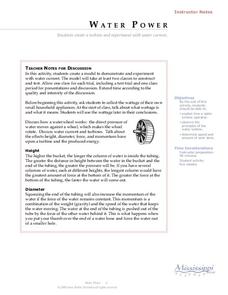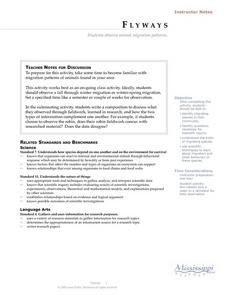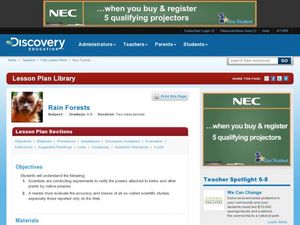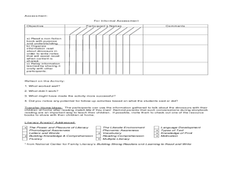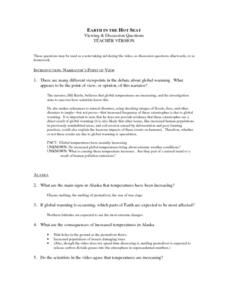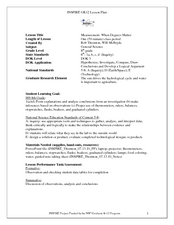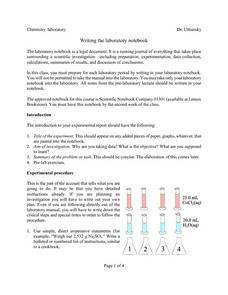Curated OER
Marine Field Trip to Whytecliff Park
Students study the intertidal habitat, tidal pools and the organisms that live in them. In this aquatic ecosystems activity students take a field trip and experience first hand the local seashore environment.
Curated OER
Woodland Animals and Their Habitat
Students explore the natural environment through a video and nature sounds tape. They keep journal's of the unit's activities and vocabulary terms. They play a web of interdependence game and compose a list of forest animals and write...
Curated OER
Amazing Animals
Learners participate in an animal research report. They present a PowerPoint presentation to the class and follow specific instructions when it comes to what to include in the report.
Curated OER
Endangered Animals in Texas
Students research endangered animal in the library and on the Internet for information on its description, habitat, forces causing its decline, and programs to help it; students create slide show about the animal that contains a clay...
Curated OER
Water Power
High schoolers explore how a water turbine operates and observe the principles of the water turbine. They account for the speed of the water turbine by various experiments and records of test results. In groups the students create a...
Curated OER
Solids, Liquids and Gases - Part 2
Young scholars experiment with balloons, soda water and raisins to find out about the states of matter. In this solids, liquids and gases lesson, students complete a group activity with balloons to recognize the state of matter in...
Curated OER
I've Got That Sinking Feeling
Students design a simple boat and predict how much weight it can carry. They should also discover why objects float or sink and how this can be determined experimentally. A great lesson on buoyancy!
Alabama Learning Exchange
Is it a Moth or a Butterfly?
Second graders examine the similarities and differences between moths and butterflies. They participate in a virtual field trip using a designated web site. They design a computer based slideshow using the information they find on the...
Curated OER
Animal Migratory patterns
Students use field research and traditional research to identify migrating species of birds as well as their migratory patterns. Students generate a list of questions regarding migration and a plan to research the questions. A field...
Curated OER
Food Webs and Making Miniature Ecosystems
Students model a food web and create a miniature ecosystem. In this animal interactions lesson, students engage in a role playing game which simulates a food web. Students then build miniature ecosystems using pop bottles, snails, plants...
Curated OER
Chameleons Are Cool!
Have your learners review what they know about camouflage using this lesson plan. Learners fill out a graphic organizer listing what they know or have questions about. This could be enhanced with the addition of a writing assignment in...
Curated OER
Rain Forests
Students watch a PowerPoint presentation about the layers of the rainforest. They create a paper rainforest in the classroom. They take notes from the presentation and write a paragraph to include in a layer book. They create a...
Curated OER
Earth History Part II
Eighth graders hypothesize what caused the break up of continents. In this earth science lesson, 8th graders study about the events that took place during Mesozoic and Cenozoic Era. They reconstruct a supercontinent and report their...
Curated OER
Digging for Dinosaur Information
Students explore how to locate dinosaur information. They read the book, Catch Me If You Can! and discuss the popularity of dinosaurs among children, identify various kinds of dinosaurs and select a dinosaur to research. TAs they...
Curated OER
Earth in the Hot Seat
Students identify the different viewpoints on the issue of global warming. While watching a video, they take notes on the issues presented to them and answer questions about what Alaska, Peru and East Africa are doing to prevent global...
Curated OER
Aquaculture Production in the Classroom
Students study the basics of aquaculture and how to successfully raise aquatic plants and animals. In this water lesson plan students perform water quality tests on fish tanks, record and graph their results.
Curated OER
Measurement: When Degrees Matter
Eighth graders record the temperature change of the beakers. In this general science activity, 8th graders create their own data table for recording observations. They discuss experimental results and cite real life applications.
Sundance
Teaching Strategies: The Giver
Can utopia be achieved? Included here are three literature worksheets to pair with Lois Lowry's The Giver. Pupils work in groups to come up with solutions to society's issues, individuals back up a statement related to a topic in the...
Nuffield Foundation
A Closer Look at Blood
Here is a lab that has teenage scientists examining samples of their own blood under a microscope. Learners carefully prepare slides, then make detailed observations and identifying different types of cells using a key.
Curated OER
Ecology
Sixth graders identify the steps of the different cycles of matter, while learning to use WP utilities.
Curated OER
I Wonder What Would Happen if Lots of Manduca Lived in a Small Place...
Students discuss the reasons why humans fight and look for similiarties in animals. They make predictions on what they think will happen when they observe insect crowding. They make conclusions about their predictions to end the lesson.
Curated OER
Writing The Laboratory Notebook
In this chemistry worksheet, students examine the given concept in order to apply in the laboratory setting. The sheet includes in depth background information.
Nuffield Foundation
Dissecting Lungs
Here is a lab activity where teens experience the respiratory system first-hand as they dissect lungs and identify key structures within the system. Although the website is written in British English with some slightly different verbiage...
Curated OER
How Do Plants and Animals Change the Environment Around Them?
If you have elodea and snails in your classroom aquarium, or if you have access to a pond with these organisms, your young biologists can set up a controlled experiment to determine how certain ecosystems respond in light and dark...






